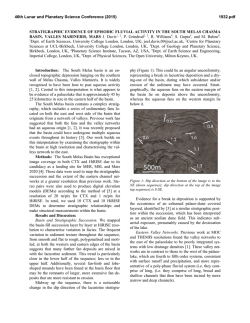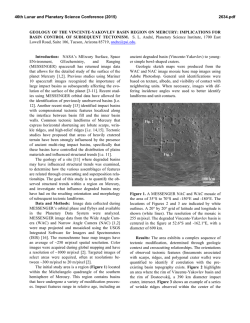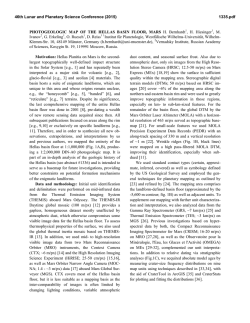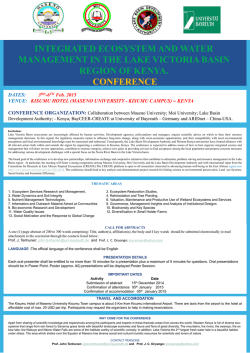
(Geot) Hidrocarbons Maturity North Flank CGSJ Arg_ Boll et al
Boll, A., Chelotti, L., Laffitte, G. y Villar H., 2000: Petroleum Habitat in the El Tordillo Oil Field and Adjacent Areas, North Flank of the Golfo San Jorge Basin, Argentina: Different Opportunities for Oil and Gas Emplacement. VII Latin American Congress on Organic Geochemistry, Abstracts. Foz do Iguaçu. Petroleum Habitat in the El Tordillo Oil Field and Adjacent Areas, North Flank of the Golfo San Jorge Basin, Argentina: Different Opportunities for Oil and Gas Emplacement. Andrés Boll 1, Luis Chelotti 1, Guillermo Laffitte 2 and Héctor Villar 3 1 Tecpetrol S.A., 2 Consultant, 3 CIRGEO VII Latin American Congress on Organic Geochemistry, Abstracts. Foz do Iguaçu, 2000. The El Tordillo Field is located in a central position of the North Flank of the Golfo San Jorge Basin (Fitzgerald et al., 1990; Figari et al., 1999) and has accumulated 30,9 MMm3 oil and 3,7 MMMm3 gas. The area is controlled by extensional faults, mainly WNW-ESE oriented, with gentle listric geometry dipping to the south, responsible for characteristic hanging wall rollover anticlines and planar antithetic faults. Master faults are segmented along strike, with relay ramp structures formed between overlapping fault tips that suggest an oblique rifting model and an older pre-Jurassic structural control (Chelotti et al., 1999). The oil field location coincides with the intersection of both systems, creating a wide faulted structural nose dipping to the south, with high exploration potential. The El Tordillo Oil Field encompasses different types of commercial hydrocarbon accumulations that represent an infrequent association in the basin. In addition, it is one of the southernmost commercial oil occurrences in the North Flank. Entrapment style is combined stratigraphic-structural with a significant fault control. Migration is predominantly vertical with minor lateral component that increases towards the basin margin. The petroleum source rock charging the system is the lacustrine D-129 shale (Hauterivian-Barremian). The Comodoro Rivadavia (Cenomanian-Turonian) and El Trébol (Coniacian-Campanian) reservoirs of the El Tordillo Field lodge medium/heavy naphthen-paraffinic asfaltene-rich black oils, which are mixtures of extensively biodegraded and underdegraded hydrocarbons resulting from several pulses of charge through geological times. This mixed oil type is analogous to the widely known hydrocarbon occurrences in the South and North Flanks (Figari et al., 1999; Jalfin et al., 1999), accounting for the main accumulated production of the basin. The upper third of Mina El Carmen (Aptian-Albian) reservoirs, involved in a particular structural situation in the El Tordillo area, bears viscous high-wax undegraded oils, which represent an atypical production related with a faulting zone. Massive occurrence of nonbiodegraded solid bitumen, genetically linked to the waxy oil, has been documented as well. Porosity development is significantly enhanced by fracturing and dissolution processes. It is viewed that this highly productive new play concept could potentially occur in other areas with similar structural behavior. The lower Mina El Carmen reservoir hydrocarbons are limited to light oil, condensate and wet gas associated to moderate amounts of CO2. Sandstone intervals within the upper D-129 Fm show presence of CO2 accumulations and minor dry gas. The occurrence of these reservoir levels with unexpected good petrophysical properties encourages future exploration, provided they are mostly charged with hydrocarbon gases. 1 Boll, A., Chelotti, L., Laffitte, G. y Villar H., 2000: Petroleum Habitat in the El Tordillo Oil Field and Adjacent Areas, North Flank of the Golfo San Jorge Basin, Argentina: Different Opportunities for Oil and Gas Emplacement. VII Latin American Congress on Organic Geochemistry, Abstracts. Foz do Iguaçu. 2 Boll, A., Chelotti, L., Laffitte, G. y Villar H., 2000: Petroleum Habitat in the El Tordillo Oil Field and Adjacent Areas, North Flank of the Golfo San Jorge Basin, Argentina: Different Opportunities for Oil and Gas Emplacement. VII Latin American Congress on Organic Geochemistry, Abstracts. Foz do Iguaçu. In order to understand this hydrocarbon distribution, a regional thermal and maturity modeling was performed in El Tordillo and neighbour areas. The analyses allowed us to discriminate five belts broadly corresponding with the main structural blocks in the area, pattern that granted different possibilities of hydrocarbon charge and potential preservation from upper Early Cretaceous to present. In the specific case of the El Tordillo area, hydrocarbon generation began in Late Cretaceous (oil phase) and spanned up to present (gas phase). This extended generation period, related to the thickness of the D-129 source rock showing significant maturity differences from bottom to top, helps explaining the multiple hydrocarbon types occurrences though the column of the El Tordillo Field. Southwards, oil generation and expulsion were already completed by the transition Cretaceous-Tertiary, the source rock was even almost exhausted for gas generation before Neogene times, thus disfavouring significant entrapment and preservation. Northwards, oil generation and expulsion phases began in the Early Tertiary and are possibly still active at present, with secondary contribution of light oil and gas hydrocarbons. The northernmost area stays in the early stages or even still immature for oil generation. 3 Boll, A., Chelotti, L., Laffitte, G. y Villar H., 2000: Petroleum Habitat in the El Tordillo Oil Field and Adjacent Areas, North Flank of the Golfo San Jorge Basin, Argentina: Different Opportunities for Oil and Gas Emplacement. VII Latin American Congress on Organic Geochemistry, Abstracts. Foz do Iguaçu. 4 Boll, A., Chelotti, L., Laffitte, G. y Villar H., 2000: Petroleum Habitat in the El Tordillo Oil Field and Adjacent Areas, North Flank of the Golfo San Jorge Basin, Argentina: Different Opportunities for Oil and Gas Emplacement. VII Latin American Congress on Organic Geochemistry, Abstracts. Foz do Iguaçu. 5 Boll, A., Chelotti, L., Laffitte, G. y Villar H., 2000: Petroleum Habitat in the El Tordillo Oil Field and Adjacent Areas, North Flank of the Golfo San Jorge Basin, Argentina: Different Opportunities for Oil and Gas Emplacement. VII Latin American Congress on Organic Geochemistry, Abstracts. Foz do Iguaçu. REFERENCES: - Chelotti, L., Czeplowodzki, R., Fortunato G., Cersósimo S. and Trinchero E., 1999: Tectónica del Flanco Norte de la Cuenca Golfo San Jorge, Argentina: el Yacimiento El Tordillo desde la Sismica 3D. In Actas Tomo I, XIV Congreso Geológico Argentino, p.p. 235-238. Salta. - Figari, E., Strelkov E., Laffitte, G., Cid de la Paz, M., Courtade, S., Celaya, J., Vottero, A., Lafourcade, P., Martínez, R. and Villar, H., 1999: Los Sistemas Petroleros de la Cuenca del Golfo San Jorge: síntesis estructural, estratigráfica y geoquímica. In Actas Tomo I, IV Congreso de Exploración y Desarrollo de Hidrocarburos, p.p. 197-237. IAPG, Buenos Aires. - Fitzgerald, M., Mitchum, M., Uliana, M. y Biddle, K., 1990: Evolution of the San Jorge basin, Argentina. In A.A.P.G. Bulletin, V. 74 (6): pp. 879-920. Tulsa. - Jalfin, G., Bellosi, E., Sanagua, J. and Villar, H., 1999: Procesos múltiples de migración, alteración y mezcla de petróleos de la Cuenca del Golfo San Jorge. In Actas Tomo I, IV Congreso de Exploración y Desarrollo de Hidrocarburos, p.p. 445-465. IAPG, Buenos Aires. 6 Boll, A., Chelotti, L., Laffitte, G. y Villar H., 2000: Petroleum Habitat in the El Tordillo Oil Field and Adjacent Areas, North Flank of the Golfo San Jorge Basin, Argentina: Different Opportunities for Oil and Gas Emplacement. VII Latin American Congress on Organic Geochemistry, Abstracts. Foz do Iguaçu. 7
© Copyright 2025






